#principal Anjou
Text

Spicy Water
A Dragon Raja fan fiction by N.S.K.

Episode 131: A Wedding pt.2
[Everyone is seated while Chisei stands at the podium]
[Nadi and Chime walk down the aisle together]
[They reach the altar, Nadi on the left with NoNo behind her, and Chime on the right with Finger behind him]
Chisei: we are gathered here today to witness the union of Chime Gen and Nadi Agnimitra. We will begin with the vows
Chime: I will always stay by your side
Nadi: I will always protect you
Chisei: Do you, Nadi, take Chime to be your husband?
Nadi: I do
Chisei: and do you, Chime, take Nadi to be your wife?
Chime: I do
Chisei: you may now kiss the bride
[Nadi and Chime kiss]
Bondarev: [happy crying while Mai sits next to him comforting him]
Renata: [sniffle] they grow up so fast
Chisei: [happy crying] they do make a lovely couple. My brother is finally married
[Nadi and Chime start walking down the aisle]
Caesar: have fun on your honeymoon! Don't forget we have another mission when you get back
Nadi: maybe now, you and NoNo can get married
NoNo and Finger: definitely!
Shavee: [to Johann] they’re so cute
Chime: so where will we go for our honeymoon, my stubborn girl?
Nadi: well, Chimchim...I was thinking we could go to that little cozy cabin in the mountains
Chime: hehe, I like the sound of that. Ruri does too. And maybe you can make more of that Spicy Water?
Nadi: I'd love to.








The End 🧡
Thank you, everyone, for reading Spicy Water and thank you for your patience. It took a very long time to publish all the episodes and get them out of the queue, but I’m so happy that I finally got the chance to conclude this fan fiction. I hope you enjoyed this journey with me. As always, stay fabulous and stay hydrated💙 -N.S.K.
<- Previous
#dragon raja#spicy water#dragon raja fan fiction#nsk#spicy water comic#dragonraja#chime gen#nadi agnimitra#caesar gattuso#chisei gen#chu zihang#johann chu#shavee#dragon raja shavee#finger von frings#principal anjou#dragon raja nono#chen motong#lu mingfei#erii uesugi
4 notes
·
View notes
Text
In 1495 Anne married Thomas, Lord Howard, later earl of Surrey, and the wedding of Catherine and Sir William Courtenay, later the earl of Devon, took place at Greenwich Palace. These court festivities had carefully calculated political and dynastic purposes, formulated by the king himself. (R. A. Griffiths)
Not criticising this author in specific, but it's disappointing that this is the traditional view and Elizabeth of York is never mentioned in that aspect despite evidence of her involvement in arranging her sisters' marriages, as well as her direct involvement in the planning of court festivities. One would think that much like Margaret of Anjou's matchmaking in her time, Elizabeth was at least as equally involved in her sisters' marriages as the king himself. It brings to mind the time Elizabeth and Henry offered a marriage arrangement to the Spanish ambassador, mainly, Henry says, at Elizabeth's insistence:
After many excuses, [Puebla] has at last been persuaded, principally by the Queen, to accept the marriage, but under the express condition that [Ferdinand and Isabella] must first give him their consent. Wishing to marry De Puebla well in England, he [Henry] and his Queen beg them to grant their prayers, and to give their consent (3 February 1498).
De Puebla later confirms it was Elizabeth's own idea:
Thanks them for not having answered the letter of Henry respecting their consent to the marriage which the Queen of England had offered to him. The King will write again on the same subject. Begs them to put off the answer again. Does not like to accept the match, because he fears [Ferdinand and Isabella] would not have so much confidence in him if he were married by the Queen of England to a rich English lady (16 June 1500).
It would be nothing extraordinary for Elizabeth of York to be one of the (if not the main) drivers of the marriages that took place at the English court, considering that was one aspect of royal patronage in which queens consort traditionally excelled. Unfortunately, however, Elizabeth of York is not usually afforded any degree of agency in traditional scholarship.
#disappointed but not surprised etc#elizabeth of york#henry vii#rodrigo de puebla#anne of york#katherine of york
34 notes
·
View notes
Text
THIS DAY IN GAY HISTORY
based on: The White Crane Institute's 'Gay Wisdom', Gay Birthdays, Gay For Today, Famous GLBT, glbt-Gay Encylopedia, Today in Gay History, Wikipedia, and more … April 26


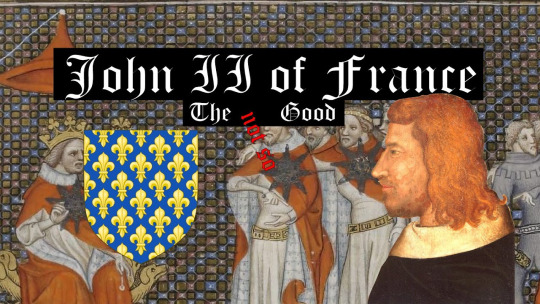
1319 – John II of France (French: Jean II) called John the Good (French: Jean le Bon), was a monarch of the House of Valois who ruled as King of France from 1350 until his death (d.1364).
When John II came to power, France was facing several disasters: the Black Death, which caused the death of nearly half of its population; popular revolts known as Jacqueries; free companies (Grandes Compagnies) of routiers who plundered the country; and English aggression that resulted in disastrous military losses, including the Battle of Poitiers of 1356, in which John was captured.
While John was a prisoner in London, his son Charles became regent and faced several rebellions, which he overcame. To liberate his father, he concluded the Treaty of Brétigny (1360), by which France lost many territories and paid an enormous ransom.
In an exchange of hostages, which included his second son Louis, Duke of Anjou, John was released from captivity to raise funds for his ransom. Upon his return in France, he created the franc to stabilize the currency and tried to get rid of the free companies by sending them to a crusade, but Pope Innocent VI died shortly before their meeting in Avignon.
When John was informed that Louis had escaped from captivity, troubled by the dishonour of this action, and the arrears in his ransom, John did something that shocked and dismayed his people: he announced that he would voluntarily return to captivity in England. His council tried to dissuade him, but he persisted, citing reasons of "good faith and honour." He sailed for England that winter and left the impoverished citizens of France again without a king. He died in England in 1364.
During his life, he hathered 11 children with his wife Bonne of Bohemia, but due to his close relationship with Charles de la Cerda, rumours were spread of a romantic attachment between the two. La Cerda was given various honours and appointed to the high position of connetable when John became king; he accompanied the king on all his official journeys to the provinces. La Cerda's rise at court excited the jealousy of the French barons, several of whom stabbed him to death in 1354. La Cerda's fate paralleled that of Edward II of England's Piers Gaveston and John II of Castile's Alvaro de Luna; the position of a royal favourite was a dangerous one. John's grief on La Cerda's death was overt and public.

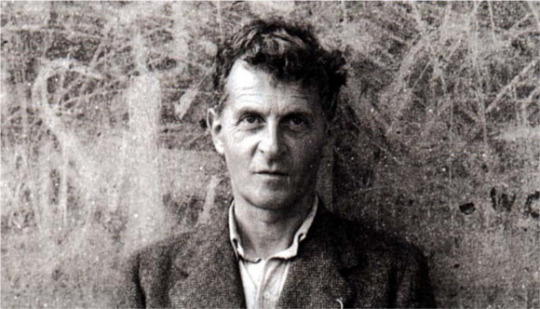
1889 – The Austrian-born philosopher Ludwig Wittgenstein was born on this date (d.1951). Wittgenstein worked primarily in the foundations of logic, the philosophy of mathematics, the philosophy of mind, and the philosophy of language. Wittgenstein is known for having inspired two of the century's principal philosophical movements, logical positivism and ordinary language philosophy, and for being one of the foremost figures in the tradition of analytic philosophy, though in his lifetime he published just one book review, one article, a children's dictionary, and the 75-page Tractatus Logico-Philosophicus (1921). Philosophical Investigations, which Wittgenstein worked on in his later years, was published shortly after he died. Both of these works are regarded as highly influential in analytic philosophy.
Wittgenstein served in World War I. In January 1917, he was sent as a member of a howitzer regiment to the Russian front, where he won several medals for bravery including the Silver Medal for Valour. In 1918 he was promoted to reserve officer (lieutenant) and sent to northern Italy as part of an artillery regiment. For his part in the Austrian offensive of June 1918, he was recommended for the Gold Medal for Valour, the highest honour in the Austrian army, but was instead awarded the Band of the Military Service Medal with Swords. Throughout the war, he kept notebooks in which he frequently wrote philosophical reflections alongside personal remarks, and in them he records his contempt for the baseness of soldiers in wartime. He discovered Leo Tolstoy's The Gospel in Brief at a bookshop in Galicia, and carried it everywhere, recommending it to anyone in distress, to the point where he became known to his fellow soldiers as "the man with the gospels".
Bertrand Russell said he returned from the war a changed man, one with both a more mystical and more ascetic bent. After the war he returned home to his family in Vienna and enrolled in a teacher training college. His sister Hermine said that Wittgenstein working as an elementary teacher was "like using a precision instrument to open crates, but the family decided not to interfere." He moved out of the family home and into lodgings in Untere Viaduktgasse in Vienna's third district, and it was during this period that, according to William Warren Bartley, a professor of philosophy at Stanford, Wittgenstein engaged in a series of casual homosexual encounters in an area of the city called the Prater, within walking distance of his lodgings. It is a controversial claim, one that Bartley first made in 1973 in his biography Wittgenstein, and which was denied at the time by Wittgenstein's executors and friends in England, who seemed to argue that, although Wittgenstein was not heterosexual, he had not actually engaged in gay sex.
Wittgenstein certainly seems to have been rather uncomfortable with his homosexuality. Certainly, he was very secretive about his sexual interests and activities. His secretiveness is not altogether surprising, considering the fact that homosexuality was illegal in Austria and Britain during his lifetime. At Cambridge John Maynard Keynes also invited him to join the Cambridge Apostles, an elite secret society formed in 1820, which both Russell and G. E. Moore had joined as students, but Wittgenstein did not enjoy it and attended infrequently. Russell had been worried that Wittgenstein, with his literal-mindedness, would not appreciate the group's humour or the fact that many of the members were in love with each other.
Lytton Strachey wrote to Keynes on 17 May 1912 about an Apostles meeting where Wittgenstein was present, calling him Herr Sinckel-Winckel: "Oliver and Herr Sinckel-Winckel hard at it on universals and particulars. The latter oh! so bright— but quelle souffrance! Oh God! God! 'If A loves B'—'There may be a common quality'—'Not analysable that way at all, but the complexes have certain qualities.' How shall I manage to slink off to bed?"
Bartley writes that he obtained the information about the Prater cruisings from Wittgenstein's friends, and it was this activity, he argues, that Wittgenstein was referring to when he wrote to the architect Paul Engelmann in May 1920: "Things have gone utterly miserably for me lately. Of course only because of my own baseness and rottenness. I have continually thought about taking my own life, and now too this thought still haunts me. 'I have sunk to the bottom'. May you never be in that position!"
The literary executors threatened legal action to suppress publication of Bartley's book, according to an afterword he included in a 1985 edition. Bartley writes that a whispering campaign began against him, with one British literary critic writing, "The general line here is that you are to be drummed out of the trade and that no academic invitation of any kind will be extended to you from the United Kingdom henceforth …"
Wittgenstein's estate and other biographers challenged him to produce the sources that he claims. What has become clear, at least, is that Wittgenstein had several long-term homoerotic attachments, including an infatuation with his friend David Pinsent - who was killed in a military flying accident in 1918 - and long-term relationships during his years in Cambridge with Francis Skinner and Ben Richards.

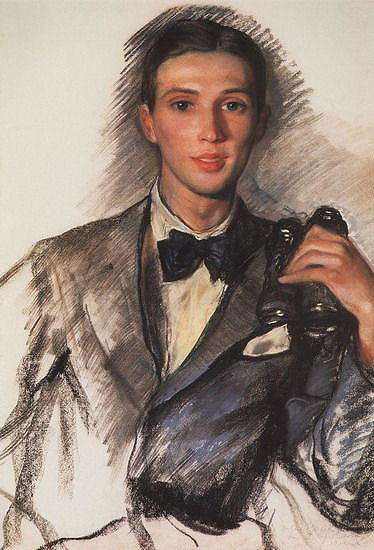
1893 – Born: Dimitri Bouchéne (also known as Beauchesne/Bushen) (d.1993). Bouchéne was the last surviving artist of Sergei Diaghilev and Alexander Benois's avant-garde group Mir Iskusstva ('The World of Art'). He appeared in three of the St Petersburg group's exhibitions before leaving Russia in the 1920s for France, where, as well as continuing painting and drawing, he worked in haute couture and theatre and ballet design. He died in Paris seven weeks before his 100th birthday.
Born in St. Tropez, he grew up in Tsarist Russia. He was a pupil at the Second Imperial (Alexander I) gymnasium and attended evening classes at the art school attached to the Society for Encouragement and Promotion of Arts. Its director was the artist Nikolai Roerich - who introduced his talented pupil to Diaghilev and Benois and Mir Iskusstva.
In 1912 Roerich gave Bouchéne a letter of introduction to a friend in Paris, Maurice Denis, a co-founder and principal theorist of the Nabis movement. There Bouchéne met Henri Matisse, who taught him to paint not what he saw but what he felt about his subject.

St. Tropez by Bouchéne
On Bouchéne's return to St Petersburg he joined the staff at the Hermitage as Keeper of Fans. He then ran the department of Russian porcelain, silver and jewels.
In 1925 he obtained permission for a three-month holiday in Paris, travelling via Tallinn with his lover, the art historian Sergei Ernst, whom he had first met at art school. They never returned to the Soviet Union.


1894/5? – Sergei Ernst (d.1980) was a Russian art historian and critic also associated with members of Mir Iskusstva ("World of Art") He was the first to write monographs on the leading artists of the Russian "Silver Age": Benua, Rerikh and Serebriakova (who painted both of the portraits used here.
He met his life-long lover and partner Dimitri Bouchène when they were both art students in St. Petersburg. In 1925 Bouchéne obtained permission for a three-month holiday in Paris, travelling together with Sergei Ernst. As previously mentioned, the couple never returned to Russia.
At a Parisian flea market, Ernst bought a Delacroix at a ridiculously low price. Reselling the painting allowed the couple to buy a home. They never returned to the Soviet Union. Bouchéne worked for the Paris Opéra and La Scala as stage designer. Ernst worked as an art critic and historian.
During the Nazi occupation of France, Bouchéne and Ernst took part in the French Resistance.

The lovers lived together all their lives and are buried in one grave in Montparnasse. The inscription reads "What a joy / You have arrived" - referring to the thirteen years between Sergei's death in 1980 and Bouchéne's in 1993 - seven weeks short of his 100th brthday.


1977 – Fredrik Eklund, aka Tag Erikkson, born in Stockholm, Sweden, is a New York City real estate broker, a former Information technology (IT) entrepreneur in his native Sweden, a gay porn actor (under the pseudonym Tag Eriksson, also written Tag Ericsson) and a novelist.
After being done with high school, Eklund studied at the Stockholm School of Economics, but never graduated. He has also worked for the financial newspaper Finanstidningen. At the age of 23, Eklund was the CEO of a company with 45 employees.

Eklund as Eriksson
Before leaving Sweden for New York City, Eklund entered a career in gay pornographic film under the pseudonym Tag Eriksson (or Tag Ericsson). He starred in the porn comedy movie The Hole (2003) (a parody of The Ring), and for this role won a GayVN award for "Best Solo Scene." He appeared in six additional pornographic movies with Jet Set Productions. He claims his background in acting has not affected his career negatively.
In New York City Eklund became Managing Director at the New York City real estate firm CORE Group Marketing and in 2010 Managing Director at Prudential Douglas Elliman, the largest real estate brokerage on the East Coast. He is currently one of three New York City brokers starring in Bravo's Million Dollar Listing New York.


1980 – Channing Tatum is an American actor. Tatum made his film debut in the drama Coach Carter (2005), and had his breakthrough role in the 2006 dance film Step Up. He gained wider attention for his leading roles in the sports comedy She's the Man (2006), the comedy-drama Magic Mike (2012) and its sequels Magic Mike XXL (2015) and Magic Mike's Last Dance (2023), the latter two of which he also produced.
His other films include White House Down (2013), Foxcatcher (2014), and The Lost City (2022). Tatum has also starred in, produced and co-directed the road film Dog (2022). Time magazine named him one of the 100 most influential people in the world in 2022.
Tatum has discussed having dealt with attention deficit disorder (ADD) and dyslexia while growing up, which affected his ability to do well in school. Growing up, Tatum played football, soccer, track, and baseball; he has said that "girls were always [his] biggest distraction in school."
He attended Glenville State College in Glenville, West Virginia on a football scholarship, but dropped out. He returned home and started working odd jobs.
Us Weekly reported that around this time Tatum left his job as a roofer and began working as a stripper at a local nightclub, under the name "Chan Crawford". In 2010, he told an Australian newspaper that he wanted to make a movie about his experiences as a stripper. That idea led to the movie Magic Mike. Tatum moved to Miami, where he was discovered by a model talent scout.
Tatum met actress Jenna Dewan on the set of their movie Step Up, and they married on July 11, 2009, in Malibu, California. They have one daughter, born in 2013. On April 2, 2018, the couple announced they were separating. Six months later, Dewan filed for divorce from Tatum. The divorce was finalized in November 2019.
Although he was married, and has been reported as dating several different actresses, rumors conting that Channing is gay, fuelled by many of his own comments about other men:
In a 2012 interview published in the UK's Sun, Tatum revealed that he'd developed a "Man Crush" on George Clooney and went on to say, "I'd have sex with him".
Channing appeared in an ET Interview in 2014 whereby he revealed a straight-up man crush on actor Jude Law.
Of a fellow actor (and out gay man) Matt Bomer: "No matter if you're a man, woman, cat, hamster, you will get lost in Matt Bomer's eyes."And here is what he wrote about actors Danny DeVito and Ron Romano:
"I'd f... Danny Devito, as I was saying earlier it could be fun. I'd marry Ray Romano, because I think he has a pretty solid perspective on marriage. I don't know who would be the male or female, you figure it out."
Channing Tatum is supportive of the LGBTQ community. In 2015, he appeared in the LA Pride Parade and many of his movies hold a queer-friendly vibe.
Some have suggested that Channing purposely engages in gay baiting, a popular term used to describe the dynamic where an actor hints at (possibly) being queer but never comes right out and says it. The reason for doing so is to whip up buzz and speculation about the person or the movie they will appear in.


1984 – Brett Novek is an American male fashion model and actor. He is a campaign level model for Papi Underwear and appears on their product packaging and sales and promotional material. In 2007, he was a contestant in season one of VH1's reality competition television program America's Most Smartest Model, in which he placed fourth.
Novek was born in Fort Lauderdale, Florida. While working out at a gym, Novek met professional model Gregg Avedon, who submitted Novek's information to a modeling agency.
In May 2007, Novek participated as one of sixteen professional model contestants in the taping of Season One of America's Most Smartest Model. The game show consisted of a series of challenges that led to each model being eliminated from the contest until only the winner remained. Novek ended the game in fourth place. When the show aired later in the year, Novek appeared in episodes 1 thru 9. At the end of the ninth episode, Novek was eliminated. According to the judges, it was because of a disappointing performance in an automobile presentation challenge and because it appeared that he had lost his motivation after his friend and fellow contestant, Jeff Pickel, was eliminated the episode before.
Novek, who is gay, lived with fellow America's Most Smartest Model contestant Jeff Pickel in Los Angeles, California. He currently lives with fellow model/actor Erik Fellows.

2010 – On this date the California Assembly by unanimous vote repealed an archaic law requiring research into a "cure" for homosexuality. The decades-old state law, written in 1950, characterized homosexuality as a "sexual deviation" that must be cured and classified Gay people as "sexual deviants." It required the state to conduct research to find the causes of sex crimes against children and singled out homosexuals as a group that should be researched. The state had long stopped conducting such research, but the law remained on the books. How many other similar archaic laws must still be lurking around in state books?


4 notes
·
View notes
Text
Friendly reminder that Francesco Coppino and Prospero di Camulio, contemporaries who were literally getting their information from predominantly Yorkist circles, were both explicitly clear that it was Henry VI who decided to surrender Berwick to Scotland.
Camulio: "King Henry has given away a castle [town] called Berwick, which is one of the keys of the frontier between England and Scotland."
Coppino: "[Scotland has] received from the same Henry the town of Berwick, on the frontiers of Scotland, which the Scots have long claimed as their right from the English, as the excellently well furnished guardian of their frontiers, and the place to which King Henry repaired as an asylum after the battle."
The idea that Margaret of Anjou was principally involved in the surrender, or that she was the one who actually made the decision, is based on nothing but assumption. Two direct contemporaries, both speaking of ongoing events as they unfolded, who were both getting information from Yorkist-held England, both clearly believed it was Henry who was responsible for this course of action. Neither of them mention Margaret. Sure, you can argue that it was merely rhetorical, and that they were simply automatically attributing such an important decision to the King rather than the queen - but rhetoric is nonetheless extremely important and helps us understand how historical figures were perceived at the time. Margaret's enemies would surely not have hesitated to broadcast her involvement had it actually been true, and Coppino in particular had shown no qualms about criticizing her in favor of the Yorkists before. If she was genuinely believed to have been responsible, and if the Yorkists were actually claiming that she was at the time, I see no reason why Coppino or Camulio would not have emphasized her role in their letters. What these samples instead indicate is literally the opposite: that their contemporaries - probably including the Yorkists who were putting out the information that Coppino and Camulio reported - actually believed that Henry was the one making the decision. I think it's a very large and very unnecessary stretch to go against actual evidence and claim otherwise by placing the responsibility on Margaret instead.
Additionally, these small samples may also reveal what people at the time - once again including the Yorkists - actually thought of Henry's role in the war on a broader level, away from direct Yorkist propaganda which would obviously and perhaps understandably seek to de-emphasize it: namely, that Henry was perceived as the one making decisions and deciding the courses of action for his own side.
Source: Excerpts from the Calendar of State Papers and Manuscripts, Existing in the Archives and Collections of Milan
#henry vi#margaret of anjou#english history#my post#I want to make a longer post detailing the clear indications we have that Henry *was* perceived as the active decision maker of his side#which indicates that contemporaries did not really think that there was some kind of giant 'role-reversal' between him and MoA#but until then the gist is:#after Henry was rescued in 1461 contemporary letters clearly emphasize his own actions; they mostly did not attribute decisions to Margaret#we also know he and Margaret separated when she headed off to the continent;#that he seems to have been involved in border-raids against Yorkist England;#*and* that he avoided capture until 1465#if Henry was entirely passive throughout it all and entirely dependent on Margaret to make decisions#I do not understand how any of this would have been possible#Instead Henry & Margaret seemed to have had more of a partnership with Margaret focusing on gaining international support#which she was very well-suited for given her powerful foreign connections#& with her taking on leadership in his absence (mainly due to imprisonment/incapacity) rather than all the time/when they were together#and like I said when it comes to Berwick contemporaries clearly believed it was Henry's decision#but also like. let's hypothetically assume that Margaret was the driving force behind it. please think of this situation logically.#whoever's idea it was Scotland was very obviously going to want a proper confirmation from the *king*#who was. yk. the actual authority of the country#even if Margaret was the one encouraging this surrender Henry's approval and agreement would have still been required#if not by the Lancastrian party then by Scotland#and again this is assuming that Margaret was actually the driving force behind it. there's no indication that she was#but ultimately contemporaries very clearly believed *Henry* was responsible#we don't know what MoA actually thought of it or what her actual involvement was (she could may encouraged it; she may have misliked it;#she may have simply been told after the decision had already been made)#but ultimately even in the most extreme case - which is contradicted by actual evidence - the final say would have been Henry's#it would be nice if this was reflected by historians?
5 notes
·
View notes
Text
A huge inheritance of the Aragonese Crown in South Italy

The Aragonese castle of Taranto (Tarde in Tarentino) is located in the region of Apulia (Pugghie in Tarentino and Puglia in Italian), in southern Italy and facing the Ionian Sea, and stands on the site of an early 10th-century Byzantine fortification intended to protect the city from Saracen and Venetian attacks.
After the fall of the Roman Empire in the 5th century, the barbarian peoples who occupied present-day Italy reached the edges of the peninsula to make it their own. The Ostrogoths and Byzantines fought over Taranto in the 6th century until the Byzantines prevailed, only to be displaced by the Lombards in the 7th century, before the Saracens established themselves and formed an emirate in the 9th century. Once again in the hands of the Byzantines, the construction of the Rocca began.
The Byzantines were expelled from Taranto in the 11th century by the Normans, who had settled in Sicily, and established a principality that lasted until the 15th century, passing from family to family: first the Hauteville for over a century, then the Staufen and Brienne in short periods of time between the 12th and 13th centuries, before falling into the hands of the Hohenstaufen, the Anjou and the Orsini until its incorporation into the Kingdom of Naples in 1465.
In 1442, the Crown of Aragon invaded the Kingdom of Naples from its Sicilian possessions, after two centuries of pretensions to occupy the south of the Italic Peninsula, but on the death of King Alfons the Magnanimous, they were separated and in 1458 Ferdinand I was proclaimed the new king of Naples, and dissolved the principality on the death of his wife, heiress of Taranto, although the title remained in force to designate the sons of the Neapolitan kings.
In 1486, Ferran II of Aragon, King of Naples until his death in 1516, ordered the castle to be enlarged to be completed in 1492, giving it its present appearance, despite the demolitions carried out in the 19th century.
When the Aragonese possessions in Italy passed into the hands of the Spanish Habsburg monarchs, the castle, also known as Castel Sant'Angelo, was reinforced. After the War of the Spanish Succession, Naples fell into the hands of the Habsburgs, who turned the Aragonese castle into a prison, whose harsh conditions can be seen in the surviving torture room.
Subsequently, Naples merged with the neighbouring island into the Kingdom of the Two Sicilies under the Spanish Bourbons (18th century), and was occupied by Napoleon's troops in the early 19th century, only to rejoin Sicily after the defeat of France and the formation of the Kingdom of Italy in 1860.
6 notes
·
View notes
Photo

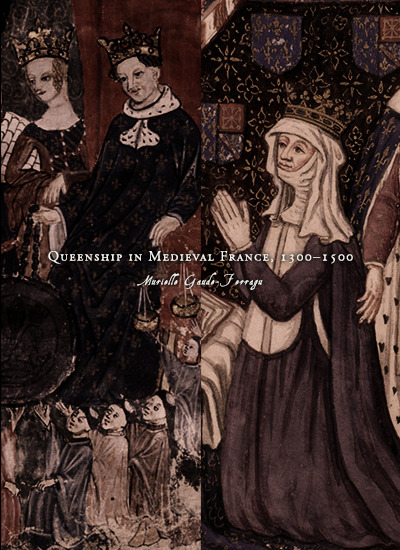
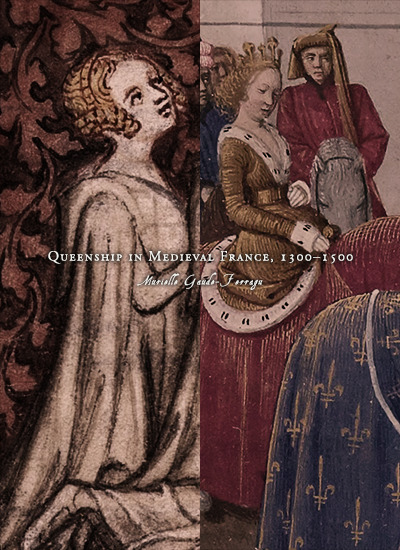
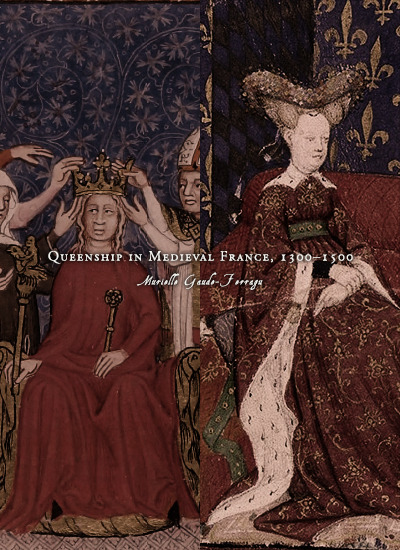

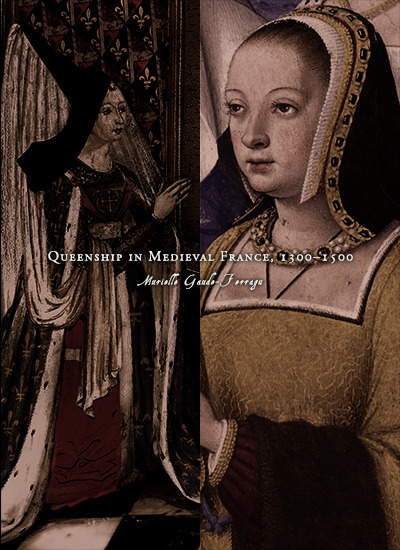
Favorite History Books || Queenship in Medieval France, 1300–1500 by Murielle Gaude-Ferragu ★★★★☆
Unlike her ... rival [Agnès Sorel], Charles VII’s wife and ‘inglorious queen’ Marie of Anjou has remained in the shadows of history. And she is not alone, for most of the fourteenth- and fifteenth-century female sovereigns have been completely forgotten. Except for historians, who still recalls the names of Clementia of Hungary, Joan of Burgundy, Joan of Évreux, Joan of Bourbon and Charlotte of Savoy? Only two queens from this period continue to figure in historical output devoted to the time: Isabeau of Bavaria and Anne of Brittany, the former for the political role she played during the civil war and the signing of the Treaty of Troyes in 1420 (when she became the woman who sold the kingdom of France to the English) and the latter because of her mythologized status as the last Duchess of Brittany, said to have fought to maintain the independence of her principality until the very end.
Further emphasizing the oblivion into which these queens have fallen, no courtly portrait placed them at the forefront of a historical event. The superb iconographical cycle Marie de’ Medici commissioned from Rubens in 1622 to decorate the Luxembourg Palace in Paris and which depicted her triumphant majesty for posterity was still a long way away. Indeed, for some time the easel portrait was reserved only for monarchs in France (up until the reign of Charles VII), but their wives were still rarely represented during the fifteenth century. Only a watercolor depicting a lost portrait of Marie of Anjou is found in the Gaignières collection held at the French National Library.
The memory of these forgotten queens therefore needs to be revived. Even so, such a task should not be about leading the reader through a gallery of individual portraits, but should, more fundamentally, involve examining the nature of their power and their roles within the court and kingdom of France. Well before the time of Catherine and Marie de’ Medici, these women were playing an essential role in the monarchy, not only because they bore the weight of their dynasty’s destiny but also because they embodied royal majesty alongside their husbands.
Indeed, since women were excluded from the French crown in 1316, they could only be ‘queen consorts’, meaning simply the wives of kings. Contrary to other European states, a princess of the French blood could not inherit the kingdom and become a full-fledged queen wielding the complete range of political powers.
... Among other issues, the history of gender has strived to define these plural roles. The place of women in medieval society has never before so thoroughly fed historiographical output on this subject in both Anglophone countries and France. Some authors have focused specifically on ‘powerful women’ in the Medieval West and the notion of ‘queenship’. The queens of France have inspired many studies, which have essentially centered around the Early Middle Ages (see Pauline Stafford and Régine le Jan) or the Early Modern Period (see Fanny Cosandey and Bartolomé Bennassar). However, there has never been a synthesis of these studies that looks at queens of the fourteenth and fifteenth centuries, which is what this work seeks to examine.
#historyedit#litedit#house of capet#house of valois#french history#european history#women's history#history#medieval#history books#nanshe's graphics
18 notes
·
View notes
Text
The year in which Normandy collapsed
The year 1204 cannot quite claim to be the annus mirabilis of Philip Augustus- that must be reserved for his triumphs of 1214- but the year in which Normandy collapsed must run it close. With the fall of Château-Gaillard, Plantagenet Normandy fell apart. Town after town, castle after castle surrendered. As with Les Andelys, so with Rouen, Philip worked his way around the target, gradually isolating it. The capital had always been his eventual target in the duchy. He first aimed against southern Normandy, moving along the River Risle. He thus foiled John's attempt to defend the River Touques, and then moved on to te valley of the Orne, making what has been called "a brilliant left-hook."
In three weeks during May Philip took Argentan and Falaise, and reaching the Normandy coast near St. Pierre-sur-Dives. Lupescar, who commanded the supposedly impregnable Falaise, surrendered within a week, and went over to Philip. Like Geoffrey of Anjou before him, Philip captured the central block of the duchy before closing in for the kill at Rouen. Domfront, Caen, Bayeux and Lisieux fell into his hands as western Normandy collapsed. Caen, standing amidst fertile fields and meadows, offered no resistance at all. It did not possess enough in the treasury to pay for its own defence, and the Plantagenet archives for the duchy were smuggled away to England. In the far west of Normandy, Philip's Breton allies under Guy de Thouars took both Mont-Saint-Michel and Avranches, then joined the French king at Caen.
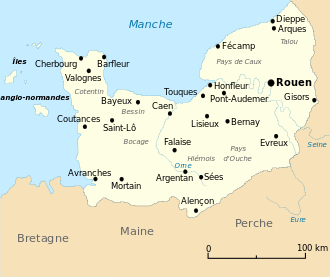
Now only Arques and Rouen in the east offered resistance in Normandy. Rouen, the major objective, was protected by double walls and triple ditches, but by now morale was low and isolation increasing. Having gained control of most of the surrounding area, the French closed in. Philip captured the barbican at the head of the bridge, and the citizens of Rouen themselves destroyed four arches of the bridge in a vain effort to prevent the French from crossing.
Philip had arrived at Rouen in May of 1204. On 1 June the Norman capital, under John's "trusty and well-beloved" Peter des Préaux, agreed to yield to Philip if no aid was received within thirty days. The city was given no hope from John and surrendered on 24 June, even before the time of the agreement was up. Normandy's fate was settled, the whole duchy was in the hands of the Capetian king, which in the words of William the Breton, "was something one had never thought possible in any circumstances."
How far John was responsible for the loss of Normandy and much of the continental Plantagenet Empire has been a matter of some debate. Warren has defended John, while Gillingham has blamed him, suggesting that so long as the Lionheart was alive the Angevin Empire was in good health.
Obviously there were various factors at play in the fall of the duchy, and there is no single explanation, which means that all the blame cannot be placed upon John. Professor Bates has seen the 'fall' of Normandy, from an independent principality, as a more gradual process. He has suggested, at least by implication, that the duchy only 'rose' and was powerful when the French monarchy was weak. The practice of Norman magnates in going over to the enemies of the dukes was not a new phenomenon and cannot alone be the explanation of John's failure; problems for the dukes from families based in the border areas had never been absent. Yet the suspicion remains that things were badly managed by John and made worse than they otherwise would have been.
The Angevin Empire had never broken out of the framework of being, with regard to its continent possessions, always in some way under the lordship of the kings of France. The absorption of Normandy into a larger political entity in both the 'Norman Empire' of the Conqueror and his immediate successors, and into the Angevin Empire of Henry II and his sons, meant that the duke was no longer able to concentrate solely on ruling Normandy. His presence was less, his interests often elsewhere. Through most of the twelfth century the duke was in no sense even a Norman. It is not surprising if loyalty to an increasingly remote ruler had waned through that period.
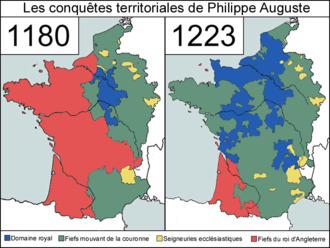
King John's aged mother, Eleanor of Aquitaine, who had done what she could to prop up his position, died on 1 April 1204. This seriously weakened his hold on the duchy of Aquitaine. Men from the south, who had come to respect the often-present Richard, and who had remained loyal while Eleanor was still alive, were without the same sense of duty to her younger son, and now rushed to do homage to Philip. The collapse of the southern Angevin Empire in 1204 was as much a voluntary surrender as a conquest.
Jim Bradbury- Philip Augustus, King of France, 1180-1223
#xiii#jim bradbury#philip augustus king of france 1180 1223#the fall of the plantagenet empire#capetians vs plantagenets#philippe ii#philippe auguste
3 notes
·
View notes
Text
La waifu con frío (Dansanko gyaru is mega cute, reseña)

Me estaba dando una vuelta por la nostalgia por lo que decidí entrar a mí cuenta de Blogger encontrándome con reseñas ya re subidas en este blog como Yancha Gal no Anjou-San o Venom; para mí sorpresa me encontré con este manga al cual no recordaba haberle hecho reseña siendo que es uno que me gusta mucho en cuestión de dibujo y en cuestión de historia bueno ya lo verán además así aprovecho la noticia de su adaptación al anime.
Argumento
Dosanko Gal wa Namara Menkoi es un manga escrito e ilustrado por Kai Ikada publicado en Shonen jump+, el cual nos cuenta la historia de Natsukawa Tsubasa un chico el cual se tiene que transferir a Hokkaidō la segunda mayor isla del territorio nipón y cuya región cuenta con un frio de los mil demonios durante el invierno y adivinen ¿Quién se mudó ahí en invierno? así es, Tsubasa. Así es como él protagonista se termina encontrando con una belleza de mujer llamada Fuyuki Mimami una Gal o Gyaryu muy atrevida, de muy buen ver por lo que de aquí en adelante comienzan las aventuras congeladas de este par qué está destinado a amarse por él resto de sus días.
Dibujo
En general este obra destaca más por su apartado visual que por otra cosa ya que si bien su trama y sus personajes son divertidos y entretenidos no deja de ser la típica trama del chico tímido que cautiva a la chica con melones de su escuela y a su rival gracias a la obra del guion, en cambio su estilo de dibujo lo encuentro fresco, no puedo llamarlo único pues deben haber más del estilo pero sí algo diferente a los estilos ya determinados entre los autores de manga. Bien saben ustedes que a nivel visual es muy difícil que tenga quejas, esta ocasión tampoco será la excepción.
Opinión
Como dije en el apartado anterior la obra destaca más por los visuales pues su trama se siente floja en ocasiones incluso para los estándares de un slide of life romcom. Pues aunque en esta obra también podemos encontrar los ya típicos teams para que los lectores decidan su dama preferida, estas solo destacan por su apariencia. Esto es algo que también afecta a Mimi —Minami— la diferencia se marca en el tiempo en que le dan a las demás para desarrollarse pues aunque cuentan con capítulos enteros y créanme cuando les digo que son capítulos seguidos —también llamados arcos— la chica principal tiene un ritmo mucho más activo lo cual hace que se te pasen volando y en donde descansa la mayoría de la comedia.
Contrastando con el ritmo lento y dramático de las otras 3. Aunque no mal interpreten sus historias son interesantes a la par que cumplidoras pues logras enfatizar con estas; solo que no la constante bomba con patas que es Mimi juega en su contra, al punto que los arcos de desarrollo de las rivales se vuelven eternos. ¡Y hablando de Mimi! Ella si en efecto se lleva toda la atención, es el alivio cómico y la que a leguas se nota que va a ganar; pero no hay nada más pese a toda la aura que la envuelve no hay nada más allá aun tomando en cuenta que le dan su debido desarrollo obvio solo se fijan en ella por sus atributos.
Como conclusión obvio les deseo el mayor de los éxitos en debut en la pantalla chica pero no le auguro algo bueno para una hipotética segunda temporada tomando en cuenta la posible extensión de la animación y el ritmo que lleva el manga estaríamos hablando de una segunda temporada un tanto tediosa al igual que una primera regular. Sin duda si te gustan los romcom tipo Yancha Gal o Nagatoro puedes darle una oportunidad al manga pero te puede llegar a aburrir después de unos capítulos y te costara mucho retomar el hilo.
Calificación final 6.8 escudos de 10
3 notes
·
View notes
Text
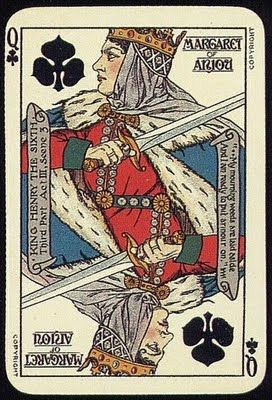
Margaret of Anjou (1430-1482) was Queen of England and nominally Queen of France by marriage to King Henry VI from 1445 to 1461 and again from 1470 to 1471.
Acc. to the usual source:
Owing to her husband's frequent bouts of insanity, Margaret ruled the kingdom in his place. She was one of the principal figures in the series of dynastic civil wars known as the 'Wars of the Roses' and at times personally led the Lancastrian faction. Some of her contemporaries, such as the Duke of Suffolk, praised "Her valiant courage and undaunted spirit" and the 16th-century historian Edward Hall described her personality in these terms: "This woman excelled all other, as well in beauty and favour, as in wit and policy, and was of stomach and courage, more like to a man, than a woman."
Margaret was taken prisoner by the victorious Yorkists after the Lancastrian defeat at Tewkesbury. In 1475, she was ransomed by her cousin, King Louis XI of France. She went to live in France as a poor relation of the French king, and she died there at the age of 52.
ADD MORE INFO.
1 note
·
View note
Text
Tal día como hoy (3 de Septiembre)
Ricardo Corazón de León fue coronado rey de Inglaterra en 1189, tras la muerte de su padre, Enrique II. También fue duque de Normandía, Anjou, Aquitania y Poitiers, y conde de Maine y Nantes.Nacido en Oxford en 1157, era el tercer hijo de Enrique II y Leonor de Aquitania.Aunque fue rey de Inglaterra, pasó la mayor parte de su reinado fuera del país, ya que su principal obsesión era la Cruzada de…
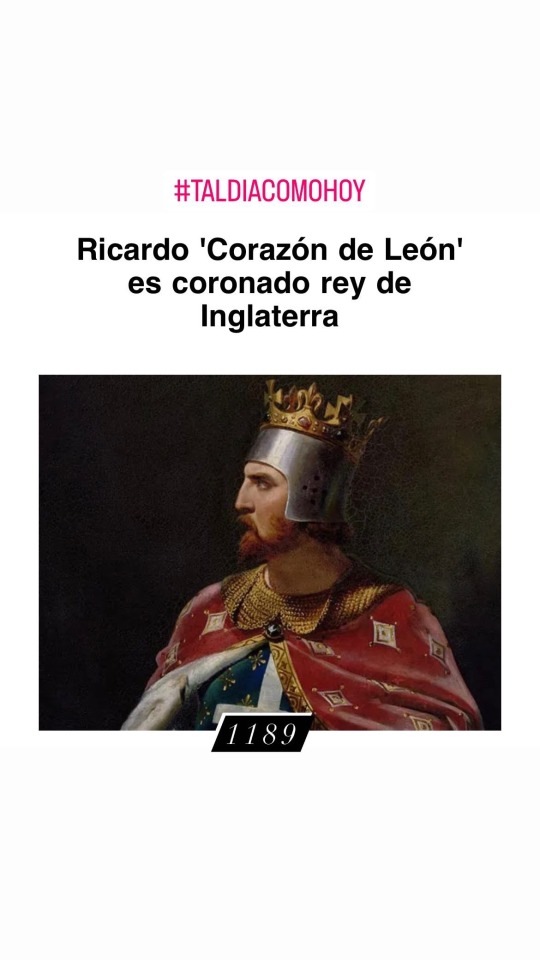
View On WordPress
0 notes
Text

Spicy Water
A Dragon Raja fan fiction by N.S.K.

Episode 125: A Sentence
Chime: I can't do it! I can't sacrifice you!
Chisei: you can
Chime: [crying] I can't
Chisei: Chime...I wasn't there for you when you needed me most. Let me do this for you
Chime: when we were kids, you always looked after me and made sure I was happy. In recent years we’ve had our issues but it was Herzog that drove us apart. We need to find another way
Chisei: there is no other way. The longer she stays there, the more difficult it will be to get her out
Chime: I need some time to think about it
[Back at Cassell College]
Anjou: fifty years
Bondarev: aw come on. I risked my life
Anjou: I can only reduce your prison sentence to five years
Caesar: Principal, I must emphasize how much he has done. I'm convinced he is reformed
Anjou: this is not up for negotiation
Johann: then maybe he can serve out his sentence with us. We'll keep an eye on him while he aids us on missions
Anjou: like community service? You lads trust him enough with that?
Caesar: yes, sir. We trust him with our lives
Bondarev: I don't usually feel nervous but, the sudden pressure of being so heavily trusted is getting to me. I did screw up on the previous mission
Caesar: it was just...a slip up
Bondarev: hehe, I see what you did there, Mr. Gattuso
Anjou: fine. You get fifty years of service to Cassell College. Caesar, you are responsible for him
<- Previous Next ->
#dragon raja#spicy water#dragon raja fan fiction#spicy water comic#dragonraja#chisei gen#chime gen#ruri kazama#caesar gattuso#anjou#dragon raja anjou#johann chu#chu zihang#bondarev#dragon raja bondarev
7 notes
·
View notes
Text
In that search for allies, in particular against France, English rulers had in the past largely confined themselves to two main sources: the Iberian peninsula and the Low Countries. But if any kind of effective encirclement of France was to be considered, or a joint north–south pincer-style operation undertaken, then an alliance – or at least a guarantee or likelihood of neutrality – might be sought with one or more of the Italian principalities or republics. And in the changed and changing political conditions of the later fifteenth century, a permanent English presence at the papal court in Rome, backed by Italian agents and allies, was also increasingly desirable [...] In 1463, both Ferdinand I, king of Naples, and Francesco Sforza, duke of Milan, became knights of the Order. Their evident value as potential, if not actual, opponents of French claims to Aragonese held Naples on behalf of the house of Anjou, and Sforza’s succession to the duchy of Milan in the face of French-backed Orleanist rivalry in 1450, made them potentially useful allies. Then, in 1474, Federigo da Montefeltro, duke of Urbino, was elected, while in 1480 Ercole d’Este, duke of Ferrara became a member. A greater presence of ‘foreigners’ among the knights of the Garter, especially under Edward IV and, to a slightly lesser extent Henry VII, may be revealing of England’s changed situation. Under Edward, eight were elected, of whom four were Italian, three Iberian and one Burgundian (Charles the Bold). Under Henry VII, six were elected, of whom three were Habsburgs (and therefore Austro-Spanish), two were Italian and one Scandinavian.
— Malcom Vale, 'England and Europe, c.1450–1520: Nostalgia or New Opportunities?' | The Fifteenth Century XIX: Enmity and Amity
5 notes
·
View notes
Text
marguerite d'anjou, dowager queen of scotland / timeline.
21 december 1452: born, marguerite d’anjou, at the château de blois, kingdom of france; first-born daughter of thebold d’anjou, duke of anjou, and christina valois, a royal french duchess.
c. 1458, aged 6: sister, agnes d’anjou, is born.
c. 1461, aged 9: betrothed to james, future king of scots.
20 july 1462, aged 10: marriage of marguerite d’anou and james stuart takes place by proxy in paris.
9 september 1466, aged 14: james, aged nineteen, becomes james v of scotland. marguerite commands her servants to refer to her as queen of scots.
c. 1467, aged 15: birth of james’ illegitimate son, archibald douglas.
c. 1468, aged 15: birth of james’ illegitimate daughter, marjorie douglas.
c. 1468, aged 16: marguerite’s party begins its journey from paris to edinburgh; their arrival is delayed by inclement weather, whereupon they are forced to dock in dover and make the trip to scotland on horseback.
17 february 1469, aged 16: unable to adjust to the harsh scottish climes, marguerite is indisposed between november 1468 and february 1469; her illness becomes so severe that james delays their marriage in the fear that she should die. finally, marguerite musters enough of her former strength (with ample pressure from her father to seal the deal) and the two marry in a private chapel at holyrood palace, attended by only a few guests (including james’ mistress, jane douglas).
27 december 1469, aged 17: having finally recovered from her prolonged illness, marguerite is crowned queen of scotland – six days after her seventeenth birthday.
24 november 1473, aged 21: birth of a daughter, arabella (future queen of scots) at holyrood palace, the queen’s principal (and favoured) royal abode.
c. 1473–1478, aged 21–26: marguerite begins an affair with thomas hepburn, earl of bothwell; he is killed in a skirmish against the english in 1478. at the time of bothwell’s death, there are whispers at holyrood that the queen may be with child; though these rumours are empty, james strains his relationship with marguerite by accusing her of having fathering arabella with bothwell.
28 august 1484, aged 32: over a decade since the birth of arabella, marguerite miscarries of a son. from this point on, james and marguerite live in separate households; marguerite must vacate holyrood and set up camp at stirling castle.
19 may 1494, aged 42: death of james v, following a prolonged illness.
c. 1494, aged 42: succession of her daughter, arabella, to the throne.
1 note
·
View note
Text
chime gen is the ONLY dude who cared about our MC and i stan him for that
also i threw suits and cigars at Anjou, now he's my sugar daddy and gives me an allowance
375 notes
·
View notes
Text
HCs for Cassel college and Anjou
I think Anjou is really interesting, he’s old, the wiki states he’s 130 years old but he looks like he’s around fifty to sixty. He can still fight like heck too. And, old men in anything anime based that are much older than humanely possible, usually means there’s something behind them that has to do with the series as a whole. Also, Anjou strikes me as a very dad like character.
This is mostly me building off what little lore we have on the game, since there’s not a lot on the college or most of the other characters.
- the college gives scholarships to students with an A or above rank in talent. Regular college is expensive, so, imagine a college that’s for dragon hybrids and is super fucking prestigious. Anjou is rich as fuck, and the school is literally a Castle hidden away in a mountain range built by a lake. Really, it looks more like a castle then a school
- On that last one, Cassel was is an ancient castle where noble bloodline of hybrids lived. Maybe Anjou is part of that line. I’m gonna make a fan fiction about this. I- just need it.
- Caesar doesn't study but Anjou really likes him so he doesn’t take away his scholarship.
- Anjou will let his students go at it unless it’s brought directly to his attention. He was probs a playboy when he was younger, so he allows it as long as no one gets pregnant. The students know this and are chill with it.
- That mountain with the college logo and those two giant statues are holy grounds. Students aren’t aloud there unless Anjou gives them direct permission
- The church was there before the castle
- I feel like Anjou lost his wife, and that pavilion over the lake near said mountain was where he married her.
- On that last one, he made EVA to make up for the daughter he lost along with his wife. EVA is short, she’s not a Lolita, but she’s small and seemingly younger than the students. Of course, she has no actual age since she’s an AI program. But, you really need to think
-Anjou built the school because he was so lonely. He sees the students as his children
- MC regardless of gender, reminds him of his wife, in the, ‘they very well could have been my child’ way. Maybe male MC does something his wife used to do, and female MC could be a spitting image of his wife. I just- Anjou strikes me as such a father like figure. A lot of teachers in my real life do. Me and my classmates sometimes call our teacher mom or dad by mistake. I need more good father figures in anime and video games, since most of them are jerks
- ok, hear me out, Anjou lets the students stay during the off season if they want to. Extra skills seem like they’re usually triggered by stress or trauma, like in MC or Luminous’ case. Anjou probably knows this and lets them stay because of that reason
-most of the students are orphans, have abusive parents, or only one parent. Idk, most of the characters strike me like that. Even if Caesar seems proud of his family name, he never mentions his father or anything. Johann has issues with his parents, idk about Nono, and Luminous probably doesn’t know his parents too well
So, yeah. I’mma write a fan fiction off this now
59 notes
·
View notes
Text
Louis VII and his great vassals
Philip Augustus owed a considerable debt to his father, not least for extending royal authority into the principalities. Louis forged links which brought the great vassals closer to a monarchy which was becoming more than one among equals, establishing the suzerainty of the Capetians. Previously the magnates had rarely attended court, only doing homage, if at all, on their borders, and providing small contingents for military service, if any. Even in the Plantagenet lands, Louis advanced the royal position. Henry Plantagenet came to Paris to give homage in return for recognition in Normandy, something previous dukes had avoided. He went again as king in 1158, acknowledging that for his French lands: "I am his man." The Plantagenet sons made frequent visits to Paris to give homage. They offered Louis lands in return for recognition, weakening their grasp on vital border territories.
Even the practice of magnates having significant functions in the palace went into decline, but now a new sort of link began to be forged. The role of the magnates was altered by the emergence of large assemblies, sometimes local, sometimes broader. The assemblies at Vézelay and Etampes, in preparation for the Second Crusade, were an important step in the significance of something akin to national assemblies.
Louis's resistance to Frederick Barbarossa also paid dividends: in Flanders, Champagne and Burgundy. Barbarossa saw Louis as a 'kinglet', and coveted the lands between their respective realms, threatening and cajoling his French neighbours. Hostile relations developed between the kings, especially during the papal schism. Again Louis's Church policy gave him advantages. His favoured candidate for the papacy, Alexander III, carried the day, and Churches in the danger area turned to him as protector, as did some of the lesser nobility. The lord of Bresse offered himself as a vassal: 'come into this region where your presence is necessary to the churches as well as to me.'
Nor was Louis easy to push against his will. Even the count of Champagne experienced the king's wrath: 'you have presumed too far, to act for me without consulting me'. Louis's third marriage, to Adela in 1160, cemented his improving relations with the house of Champagne. He had transformed French policy to ally with the natural enemies of Anjou. Adela's brothers, Theobald V count of Blois, Henry the Liberal count of Champagne, Stephen count of Sancerre, and William who would be archbishop of Reims, became vital supporters of the crown; Theobald and Henry also married Louis's two daughters by Eleanor. The crown therefore did not have to face Henry II alone. When in 1173 Louis encouraged the rebellion by Young Henry, he could call to his support the counts of Flanders, Boulogne, Troyes, Blois, Dreux and Sancerre.
In the south Louis attempted to improve his position through marriage agreements. His marriage to Eleanor gave him an interest in Aquitaine, which was not completely abandoned after the divorce. He married his sister Constance to Raymond V count of Toulouse in 1154. In 1162 Raymond declared: 'I am your man, and all that is ours is yours.' It is true that Raymond' s marriage failed, his wife complaining 'he does not even give me enough to eat', and that Raymond flirted with a Plantagenet alliance, but only to join Richard against his father. By 1176 he had returned to the Capetian fold.
Louis used marriage as a prospect to cement relations with Flanders. Louis had brought Flanders into the coalition against Henry II, and now agreement was made for his son Philip to marry Isabella of Hainault, the count of Flanders' niece. The dukes of the other great eastern principality, Burgundy, were a branch of the royal family. As Fawtier has said, it was 'the only great fief over which royal suzerainty was never contested' - at least until the time of Philip Augustus. At Louis VI's coronation, three princes of the realm had refused to give homage. By the accession of Philip Augustus, liege homage of the great vassals to the crown had become the expected practice.
Vassals of the princes sometimes turned directly to the king for aid rather than to their own lords. Many in the south sought Louis's protection, including the viscountess of Narbonne, who declared: 'I am a vassal especially devoted to your crown'. Roger Trencavel received the castle of Minerve from Louis and did homage for it, though he was a vassal of the count of Toulouse, and the castle was not even the king's to give. William of Ypres, though a vassal of
the count of Flanders, asked Louis to enfief his son Robert. Under Louis, not only were the great vassals brought closer, but Capetian influence was filtering through to a lower stratum of vassals.
Jim Bradbury - Philip Augustus, King of France, 1180-1223

#xii#jim bradbury#philip augustus king of france 1180-1223#louis vii#philippe ii#henry ii plantagenêt#frédéric barberousse#pope alexander iii#adèle de champagne#thibaut v de blois#henri i de champagne#étienne de sancerre#guillaume aux blanches mains#marie de france#alix de france#aliénor d'aquitaine#constance de france#raymond v de toulouse#philippe d'alsace#isabelle de hainaut#roger trencavel
2 notes
·
View notes